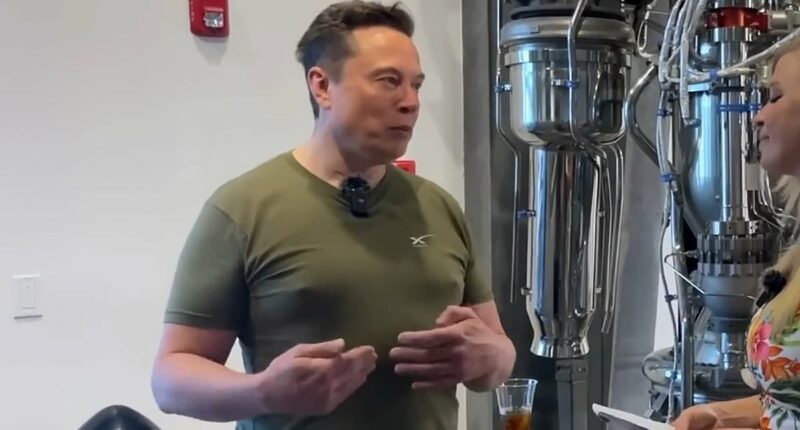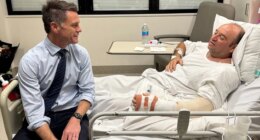Share this @internewscast.com
When the billionaire Elon Musk appeared at the World Cup in Qatar in December 2022 wearing a tight khaki T-shirt, he may have hoped to project a confident, commanding image.
Instead, the world’s richest man found himself the target of mockery on his own platform, X, as users fixated on the shape of his chest – accusing him of sporting so-called ‘man boobs’, or ‘moobs’, as they’re unaffectionately dubbed.
Some joked he was ‘Making Moobs Great Again’, a riff on US President Donald Trump’s campaign slogan, while others, less kindly, christened him ‘Adolf Titler’.
For men and boys who develop gynaecomastia – the medical term for enlarged male breast tissue – such teasing will be all too familiar. It’s a condition that is far more common, and psychologically damaging, than many realise.
Celebrities including Take That’s Gary Barlow and Strictly judge Craig Revel Horwood have all been candid about their own struggles with moobs and the effect on their confidence and sense of masculinity.
The Office for National Statistics estimates that between 20 and 40 per cent of men – up to 12 million in the UK – develop a degree of gynaecomastia at some point during their lives.
It is a normal part of puberty, as hormonal imbalances cause temporary breast tissue growth in up to half of boys before it largely resolves itself.

Elon Musk was targeted by social media users fixated on the shape of his chest in 2022
It can also affect men over the age of 55 as levels of the sex hormone testosterone drop naturally with age, allowing the female sex hormone, oestrogen – which fuels breast tissue growth – to become more dominant.
A common but underdiagnosed genetic condition, Klinefelter syndrome, which affects one in 600 male births and means men are born with an extra X chromosome, may also result in moobs.
But in many cases it’s driven by weight gain or the hormonal side effects of prescription medication. However, a growing number of cases are also linked to the misuse of anabolic steroids and cannabis smoking, which seems to lower testosterone levels.
Experts say it should always be taken seriously – not least because, in rare cases, it can be a sign of breast cancer.
About one per cent of all breast cancer cases occur in men – equivalent to around 350 a year.
A recent study also found that men with enlarged breast tissue had a 37 per cent higher risk of death, and it was a ‘canary in the coalmine’, the researchers said, because it could reveal underlying disease or the effect of medication.
Whatever the cause, too many men put up with it – either because they are too embarrassed to seek help or it isn’t severe enough.
Plastic surgeon Jeyaram Srinivasan, from the British Association of Plastic, Reconstructive and Aesthetic Surgeons (BAPRAS), says the impact, for the one to five per cent of men who develop breasts equivalent in size to a woman’s C-cup, must not be ignored.
‘Men with this condition feel totally stigmatised and emasculated, and are very limited in their personal relationships and their ability to do anything – particularly sports, and especially in the summer, when they feel they can’t wear T-shirts or vests,’ Mr Srinivasan says.
‘They live with significant psychological stigma, and because the NHS doesn’t offer surgery to correct it, they learn to live with it.
My GP seemed to imply that I was just being vain when I questioned how long the symptoms might last
‘But some of the men I’ve met are bordering on suicidal. It deeply affects them.
‘They feel isolated from family and friends, and it’s common for them to not feel comfortable starting a relationship. It can be a hard and lonely life.’
Last week The Mail on Sunday’s resident GP columnist, Dr Ellie Cannon, asked readers to get in touch if they, or their loved ones, had experienced this condition.
One 72-year-old described developing painful moobs in 2023 which kept growing and made him feel embarrassed to wear a T-shirt.
Once cancer was ruled out, he said: ‘My GP seemed to imply that I was just being vain when I questioned how long the symptoms might last.’
Another man described how he had put up with moobs all his life until he finally had surgery to remove them aged 54, which gave him a huge boost in confidence.
There are steps men can take to prevent gynaecomastia – and treatments that don’t always require costly private surgery.
First, any change in the chest area should be checked by a GP to rule out cancer.
Mo Akhavani, co-founder of The Plastic Surgery Group, says: ‘Alarm bells ring particularly if it only affects one side of the chest, and if there’s bleeding or discharge through the nipple. Doctors may not consider breast cancer in men, as it’s rare, but always push for it to be ruled out.’
One of the most common causes is excess weight.
‘Fat in the body converts testosterone to oestrogen and, while it’s complex, the result can be this increase in breast tissue,’ says plastic surgeon Paul Harris, a BAPRAS council member who carries out many gynaecomastia surgeries. ‘I see lots of young men who have been overweight during childhood, and they get this rapid growth during puberty which leads to gynaecomastia.
‘When they hit their 20s, they slim down and they’re left with what are large breasts. Childhood obesity is undoubtedly driving some of this.’
While losing weight and exercising can, for some men, reverse the problem by reducing fat all over the body, it doesn’t work in every case.
Mr Srinivasan says: ‘In some cases diet and exercise can get rid of some of the fat but in many cases it won’t – it’s a bit hit-and-miss where you lose fat, and the chest area isn’t an easy place to get rid of it. But it’s worth trying in the first instance.’
Mr Harris adds that even men who have successfully used weight-loss drugs such as Wegovy and Mounjaro are still left with moobs, which may require surgery to remove. This is partly because of excess skin, but also because not all gynaecomastia is linked to fat.
In more established cases, it’s caused by the growth of glandular tissue, which is firmer than fat and more like a developed breast. Mr Harris says: ‘If it’s established gynaecomastia then nothing will touch it.’
This type tends to be linked to hormonal imbalances, which can be triggered by prescription medications that either lower testosterone, raise oestrogen or directly affect breast tissue.
The most common are spironolactone, used to treat heart failure, high blood pressure and liver disease, and finasteride, given to men with an enlarged prostate or prostate cancer to block testosterone.
Acid reflux treatment cimetidine and the anti-psychotic drug risperidone are also known to cause moobs.
There are also reports of statins, used to lower cholesterol, causing problems, though there is less evidence for this.
If a GP suspects medication is to blame, it may be possible to switch to a different drug and the problem should resolve itself.
Mail on Sunday reader Charles Stubley, 80, from Malton, North Yorkshire, developed the problem after taking finasteride for an enlarged prostate. ‘I stopped taking the finasteride, and after a month or two the problem disappeared,’ he said.
If this does not ease the issue, patients can be given low doses of tamoxifen – a drug used to prevent the recurrence of certain types of breast cancer by blocking oestrogen receptors in breast tissue – which can reduce the size and tenderness of moobs.
Mr Harris says: ‘I’ll often put patients on it post-operatively to stop any residual gland getting activated. It will take it down and means it won’t be so painful.’
A growing problem, experts warn, is the rise in men – particularly young men – misusing steroids and drugs such as cannabis.
‘I see lots of big gym-goers who take protein supplements which contain whey, which contains soya that then reacts with the oestrogen receptors in the body so you end up with gynaecomastia,’ says Mr Harris. ‘Or they’re buying anabolic steroids from other gym users to bulk out.’
Anabolic steroids – synthetic versions of testosterone – raise hormone levels far above normal, and the body compensates by converting the excess testosterone into oestrogen. This leads to growth of male breast tissue and the shutdown of natural testosterone production.
Ollie Matthews, 39, from Norwich, learned this the hard way.
Now a functional medicine practitioner with his company Ojay Health, Ollie developed gynaecomastia in his teens after putting on weight when his father died.
After he started bodybuilding to boost his confidence, he began taking steroids, which affected his hormones even further.
He eventually needed to begin taking testosterone replacement therapy (TRT).
‘Steroids screwed up my body, and the TRT, which I took without much guidance, only made it worse. That’s when I started getting lumps under my nipples,’ Ollie says.
‘It hit my confidence. I didn’t want to wear certain things to the gym and began getting really self-conscious. I hope to have surgery soon.’
Surgery in the UK is expensive, typically £5,000–£10,000 depending on the clinic – but it is effective in the long term.
There are two main options: liposuction, which removes fat and leaves minimal scarring, and gynaecomastia surgery, which removes glandular tissue, or the ‘breast disc’, and tightens the skin.
‘Often, liposuction alone is enough to resolve it in people with what we call grade one gynaecomastia, which is often referred to as pseudo-gynaecomastia because it’s just fat,’ says Mr Srinivasan. ‘That can take under an hour. But if you need gynaecomastia surgery, that can take around two hours.’
Mr Harris says techniques have improved enormously in the past decade, though there will still be some scarring.
This can be minimised if the surgeon cuts around the dark skin of the nipple area, where it meets the patient’s normal skin tone. Sometimes it can be done via keyhole surgery, removing breast tissue through tiny incisions made for liposuction instruments after breaking up the tissue with a laser.
‘That’s really important,’ Mr Harris says. ‘Patients who don’t take their tops off because of their gynaecomastia don’t want to be left with physical scars – they might look better in a T-shirt, but they still won’t want to take it off.’
For advice and to find a surgeon visit bapras.org.uk.
Left with scars… but they look cool
At its worst, Sam Sawyers resorted to taping down his C-cup moobs to avoid embarrassment in public.
The 23-year-old, who lives near Oxford, spent years being teased mercilessly over his chest, which swelled after he hit puberty in his early teens.
Already overweight, he was targeted by school bullies who poked him every day.


Sam Sawyers struggled to get rid of his moobs, despite losing 5st, and had them removed last year after he was diagnosed with gynaecomastia
He never took his top off for fear of ridicule and always wore a T-shirt when swimming. ‘It affected every area of my life,’ he says today. ‘I used to tape them to the side under my armpit but ended up ripping the skin. Sometimes I would bleed through the tape – it was horrible.’
Even after losing 5st two years ago, the moobs stubbornly remained – ‘which wasn’t great for my mentality’, says Sam.
Now an online fitness coach, he was diagnosed with gynaecomastia by a doctor in the UK but chose to have surgery in Poland in July last year. It finally left him feeling confident in his own skin.
‘Now all I think about is tomorrow and bettering myself,’ he says.
‘I’ve missed out on quite a lot in life because of gynaecomastia and not knowing what it was. It needs a lot more awareness.
‘I now post pictures on social media to show people they can do it, too. The scars don’t really bother me – I think they look pretty cool.’






